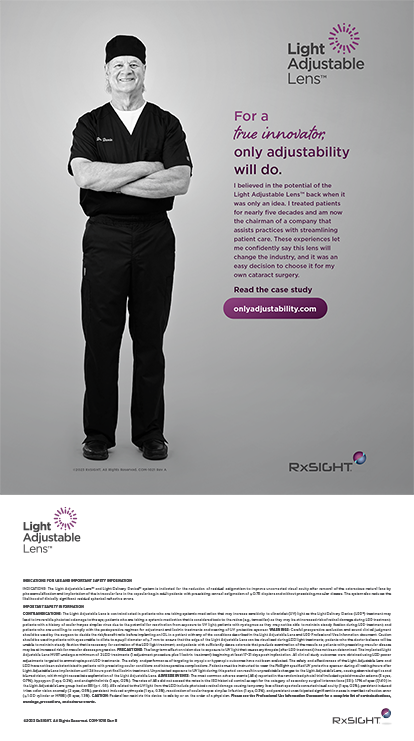Not Taking a Proactive Approach Could Negatively Impact Global Ocular Health
Vittorio Mena, OD, MS
New Jersey

Aristotle first described myopia in 350 BC.1 Evidence suggests that the worldwide prevalence of the disorder is rising—from 27% in 2010 to 33% in 2020. It is estimated that 52% of the global population will be myopic in 2050 and that 10% of those individuals will have high myopia.2 To combat the statistics and tackle the urgent health care problem, the AAO formed a task force on myopia in 2019.
RISK FACTORS
The risk factors for myopia include younger age, a family history of myopia (one or both parents), Asian race, cycloplegia (<0.75 D) at 6 years of age, excessive near work at less than 25 cm, less time spent outdoors, prolonged time in dim lighting, fewer sleeping hours, and living in an urban setting. Exposure to cell phones and smart tablets as a child is another factor; one study found that more than 6 hours of screen time per day doubled the rate of myopia.3
A yearly rate of myopic progression equal to a -0.50 D change in a White population and a -0.87 D change in an Asian population is considered normal.4 The Northern Indian Myopia study of 10,000 school-aged children (5–15 years old) from Delhi reported annual myopia progression of -0.27 ±0.42 D.5 It would thus be reasonable for eye care providers to evaluate young patients for myopia at least every 6 months.
The younger the child’s age at the onset of myopia, the faster the condition progresses. Children diagnosed with myopia between the ages of 7 and 8 years have a 50% risk of developing high myopia. The risk drops to 30%, 20%, and 5% when the age at diagnosis is 9, 10, and 12 years, respectively.6 Each additional diopter of myopia increases a child’s risk of developing myopic maculopathy by 67%.5 Slowing myopia progression by just 1.00 D could reduce the risk of visual impairment by 25%, open-angle glaucoma by 20%, and myopic maculopathy by 40%.7
EDUCATION
The gravity of the myopia epidemic and the importance of early detection and intervention are not generally understood. In September 2019, the Global Myopia Awareness Coalition surveyed 4,000 parents in the United States. Most of them (88%) thought comprehensive exams were unnecessary until children reached school age, and about half (48%) thought pediatricians could perform the exams.8
More than 60% of children with myopia worldwide are treated with single vision lenses.9 I therefore make a point to educate patients and their parents on all the options available for myopia management. Asking parents pertinent questions about how they obtain information on possible solutions for myopia, their immediate and long-term concerns regarding their child’s vision, their attitude regarding the cost of myopia management, and what information they are seeking help me determine a plan for their child.
I discuss the following treatment options with patients and their parents:
- Low-dose compounded atropine (either 0.025% or 0.05%);
- Daily disposable center-distance multifocal contact lenses;
- Orthokeratology;
- Bifocal glasses; and
- Glasses designed specifically for myopia management (not available in the United States).
TREATMENT
No single treatment option suits every patient, but daily disposable contact lenses are my general preference if the child and parent concur. In November 2019, the FDA approved MiSight (CooperVision), daily disposable soft multifocal center-distance contact lenses for myopia management for use in patients aged 8 to 12 years. The lenses are available in powers up to -7.00 D. NaturalVue (Visioneering Technologies) daily disposable multifocal contact lenses may be used off label for myopia management. They are available in powers ranging from -0.25 to -12.00 D and have a higher add power than MiSight. In 2021, the FDA approved Acuvue Abiliti (Johnson & Johnson Vision) overnight therapeutic lenses for myopia management. The lenses are used for orthokeratology, so the patient wears them only while sleeping.
If the child is younger than 5 years of age, I advise parents to increase the patient’s time outdoors and reduce their screen time. A meta-analysis of randomized controlled trials found that spending more than 14 hours outside per week slowed the rate of myopia even when both parents were myopic.10 I also recommend that children sit at least 8 feet away from the television and hold reading materials at least 14 inches away from their eyes, with a break taken every 30 minutes.
Finally, I counsel patients and their parents on the importance of adequate sleep and a healthy diet. An epidemiological cross-sectional study suggested the consumption of refined carbohydrates may be associated with myopia in children.11
1. Magnus H. The knowledge of visual disturbances among the Greeks and Romans. Graefes Arch Clin Exp Ophthalmol. 1877;23:24-48.
2. Nouraeinejad A. More than fifty percent of the world population will be myopic by 2050. Beyoglu Eye J. 2021;6(4):255-256.
3. Hansen MH, Laigaard PP, Olsen EM, et al. Low physical activity and higher use of screen devices are associated with myopia at the age of 16-17 years in the CCC2000 Eye Study. Acta Ophthalmol. 2020;98(3):315-321.
4. Donovan L, Sankaridurg P, Ho A, Naduvilath T, Smith EL III, Holden BA. Myopia progression rates in urban children wearing single-vision spectacles. Optom Vis Sci. 2012;89:27-32.
5. Saxena R,Vashist P, Tandon R, et al. Prevalence of myopia and its risk factors in urban school children in Delhi: the North India Myopia Study (NIM Study). PLoS ONE. 2015;10(2):e0117349.
6. Hu Y, Ding X, Guo X, Chen Y, Zhang J, He M. Association of age at myopia onset with risk of high myopia in adulthood in a 12 year follow up of Chinese cohort. JAMA Ophthalmol. 2020;138(11):1129-1134.
7. Bullimore M, Brennan NA. Myopia control: why each diopter matters. Optom Vis Sci. 2019;96(6):463-465.
8. Global Myopia Awareness Coalition. New survey reveals vision is deprioritized by parents in children’s overall health. Optik Now. December 6, 2019. Accessed March 8, 2023. https://www.optiknow.ca/2019/12/06/new-survey-reveals-vision-is-deprioritized-by-parents-in-childrens-overall-health
9. Wolffsohn JS, Calossi A, Cho P, et al. Global trends in myopia management attitudes and strategies in clinical practice – 2019 update. Cont Lens Anterior Eye. 2020;43(1):9-17.
10. Cao K, Wan Y, Yusufu M, Wang N. Significance of outdoor time for myopia prevention: a systematic review and meta-analysis based on randomized controlled trials. Ophthalmic Res. 2020;63(2):97-105.
11. Berticat C, Mamouni S, Ciais A, Villain M, Raymond M, Daien V. Probability of myopia in children with high refined carbohydrates consumption in France. BMC Ophthalmol. 2020;20(1):337.
It Starts in Childhood
Angie Wen, MD
New York

Myopia is the most common ocular disorder worldwide. It affects people of all ages, but recent research emphasizes the importance of detection and treatment during early childhood, when there is the potential to slow the condition’s progression.
IMPACT
Myopia is the leading cause of visual impairment in children. Its incidence is increasing rapidly—from an estimated 27% of the world’s population in 2010 to a projected 52% by 2050.1 The condition is a public health concern in East Asian countries, where 80% to 90% of high school graduates are affected and 10% to 20% of them have sight-threatening pathologic myopia.2
Uncorrected myopia can affect a person’s physical, emotional, and social functioning. The condition also has a major economic impact—268.8 billion international dollars in 2004—through lost productivity.3 Pathologic myopia is especially devastating; it confers an increased risk of cataract development, retinal detachment, glaucoma, and blindness.
ETIOLOGY AND DETECTION
It has been theorized that visual input to the peripheral retina regulates adjacent scleral growth and remaining peripheral hyperopic defocus, even with corrective myopic spectacles, may be associated with globe elongation. Environmental risk factors include time spent indoors, excessive near work, and a societal shift toward dependence on phones, tablets, and computers.
The ideal window for treatment to prevent myopia appears to be in the pediatric age group. Vision testing in schools can therefore aid in early myopia detection, especially if coupled with referrals for possible further evaluation by a pediatric ophthalmologist. Additionally, teachers can be trained to detect potential visual impairment in young children, and heightened public awareness can help caregivers identify children at particular risk, including those with genetic factors such as familial heredity and Asian ethnicity.
PREVENTION
Time spent outdoors seems to have an inverse dose-dependent relationship with the risk of myopia. Hypothesized protective mechanisms include relaxed accommodation, pupillary constriction, and light-stimulated retinal release of neurotransmitters that inhibit increases in axial length. Time spent outdoors seems to help prevent the onset of myopia but unfortunately has no effect on the condition’s progression, which highlights the importance of early detection.4
Children are being introduced to screens at a younger age; this is especially true during the COVID-19 pandemic and with remote school learning. Cumulative near work hours are associated with higher odds of myopia, with a 2% increase for every additional diopter-hour of near work performed per week.5
Unfortunately, near work and leisure time on screens can be at odds with outdoor activity and exposure to sunlight. Parents who are concerned about their children’s developing nearsightedness should be encouraged to prioritize outdoor activities such as sports and time in nature and develop a repertoire of indoor activities not related to screens or near work for rainy days.
Currently, the World Health Organization and American Academy of Pediatrics recommend no screen time for children younger than 2 years of age and less than 1 hour a day for children who are 2 to 5 years old.
TREATMENT
Three common treatments for children who have begun to develop myopia are described here.
Soft contact lenses. Studies show significant slowing of myopia progression and axial length elongation over 4 years with MiSight dual-focused soft contact lenses, including in children who started using the lenses at later ages.6
Orthokeratology. This treatment involves wearing a rigid gas permeable contact lens overnight to alter the corneal curvature. The practice was previously thought to have only temporary effects, but it can reduce globe elongation in children.7
Medical therapy with atropine. This can have an antimuscarinic impact on receptors in scleral fibroblasts that slow increases in axial length. Even low-dose atropine (0.05%) seems to reduce progression. Side effects have been minimal during therapy, and rebound side effects have been minimal once therapy ceases.8 Biotech companies are developing modalities to help children administer eye drops themselves and assist parents in helping their children adhere to the daily regimen.
CONCLUSION
The myopia epidemic is growing at an alarming rate. Near-work demands in an increasingly digital world threaten to accelerate the increase. The problem can be mitigated for future generations through earlier detection and treatment. Encouraging outdoor play and minimizing screen time should be a mainstay of prevention. Identifying candidates for contact lens and atropine therapy can help minimize myopia progression. Myopia research must continue, and efforts must be implemented to reach the communities most at risk.
1. Fricke TR, Jong M, Naidoo KS, et al. Global prevalence of visual impairment associated with myopic macular degeneration and temporal trends from 2000 through 2050: systematic review, meta-analysis and modelling. Br J Ophthalmol. 2018;102(7):855-862.
2. Ma Y, Qu X, Zhu X, et al. Age-specific prevalence of visual impairment and refractive error in children aged 3-10 years in Shanghai, China. Invest Ophthalmol Vis Sci. 2016;57(14):6188-6196.
3. Smith TS, Frick KD, Holden BA, Fricke TR, Naidoo KS. Potential lost productivity resulting from the global burden of uncorrected refractive error. Bull World Health Organ. 2009;87(6):431-437.
4. Xiong S, Sankaridurg P, Naduvilath T, et al. Time spent in outdoor activities in relation to myopia prevention and control: a meta-analysis and systematic review. Acta Ophthalmol. 2017;95(6):551-566.
5. Huang HM, Chang DS, Wu PC. The association between near work activities and myopia in children-a systematic review and meta-analysis. PLoS One. 2015;10(10):e0140419.
6. CooperVision releases four-year data on landmark MiSight 1 Day Contact Lens Study; pioneering approach slows myopia progression in children. News release. CooperVision. September 18, 2018. March 8, 2023. https://coopervision.com/our-company/news-center/press-release/coopervision-releases-four-year-data-landmark-misight-1-day
7. Santodomingo‐Rubido J, Villa‐Collar C, Gilmartin B, Gutiérrez-Ortega R, Sugimoto K. Long‐term efficacy of orthokeratology contact lens wear in controlling the progression of childhood myopia. Curr Eye Res. 2017;42(5):713-720.
8. Yam JC, Jiang Y, Tang SM, et al. Low-Concentration Atropine for Myopia Progression (LAMP) Study: a randomized, double-blinded, placebo-controlled trial of 0.05%, 0.025%, and 0.01% atropine eye drops in myopia control. Ophthalmology. 2019;126(1):113-124.
Children Should Be Screened by Age 6
James S. Wolffsohn, BSc(Hons), MBA, PhD
United Kingdom

As the epidemic of myopia grows worldwide,1 it is important that eye care providers take a proactive approach to minimizing myopic progression and reducing patients’ risk of developing ocular pathology later in life.2,3 There is solid evidence that a child’s likelihood of developing myopia in the future can be predicted by the time they are 6 years old.4,5 Screening children at this age is therefore important. Every child and every diopter matter.6
Time outdoors can reduce the incidence of myopia and slow disease progression,7,8 but for most children, further intervention is required. Randomized controlled trials have shown that treatment with soft contact lenses and spectacles designed specifically for myopia control, orthokeratology, and topical atropine drops can slow the progression of myopia.9,10
It is taking a while for eye care practitioners to adopt these strategies,11,12 but attitudes and practices are becoming more proactive.13 The International Myopia Institute, for which I am the chief scientific officer, aims to consolidate the evidence base for practitioners to keep them abreast of the latest developments and advocate for myopia control with regulators worldwide. The International Myopia Institute (IMI) was formed after a meeting between the Brian Holden Vision Institute and the World Health Organization. These organizations have identified myopia as a serious health concern.14 (See IMI Forthcoming Reports on Myopia.)
IMI Forthcoming Reports on Myopia
- Onset and Progression of Myopia in Young Adults
- Management and Investigation of High Myopia in Infants and Young Children
- Non-Pathological Human Ocular Tissue Changes With Axial Myopia
- The Dynamic Choroid – New Insights, Challenges, and Potential Significance for Human Myopia
- Global Trends in Myopia Management Attitudes and Strategies in Clinical Practice – 2022 Update
- The 2023 Digest, updating the 2019 and 2021 reports
At Aston University, we have a long history of myopia research. We have conducted randomized, controlled, long-term (up to 10 years) trials on new treatments, including contact lenses, spectacles, and pharmaceuticals, to assess their safety and efficacy. We also have an active clinic open to the public, who is becoming more aware of the health concerns. A full sight test is performed that includes an evaluation of retinal health. Additionally, the key risk factors for myopic development, including parental myopic status, refractive error (using a cycloplegic agent where necessary to relax accommodation), and axial length, are assessed.
Communication with parents, guardians, and children is vital to explaining the predictive growth curves for myopia development5 and guiding the choice of treatment.9 Follow-up typically occurs at 6-month intervals to review myopia progression and assess whether a change in approach is necessary.15
1. Holden BA, Fricke TR, Wilson DA, et al. Global prevalence of myopia and high myopia and temporal trends from 2000 through 2050. Ophthalmology. 2016;123(5):1036-1042.
2. Wolffsohn JS, Flitcroft DI, Gifford KL, et al. IMI – myopia control reports overview and introduction. Invest Ophthalmol Vis Sci. 2019;60:M1-M19.
3. Chua SY, Sabanayagam C, Cheung YB, et al. Age of onset of myopia predicts risk of high myopia in later childhood in myopic Singapore children. Ophthalmic Physiol Opt. 2016;36(4):388-394.
4. Zadnik K, Sinnott LT, Cotter SA, et al. Prediction of juvenile-onset myopia. JAMA Ophthalmol. 2015;133(6):683-689.
5. McCullough S, Adamson G, Breslin KMM, McClelland JF, Doyle L, Saunders KJ. Axial growth and refractive change in white European children and young adults: predictive factors for myopia. Sci Rep. 2020;10(1):15189.
6. Bullimore MA, Brennan NA. Myopia control: why each diopter matters. Optom Vis Sci. 2019;96(6):463-465.
7. Sherwin JC, Reacher MH, Keogh RH, Khawaja AP, Mackey DA, Foster PJ. The association between time spent outdoors and myopia in children and adolescents: a systematic review and meta-analysis. Ophthalmology. 2012;119(10):2141-2151.
8. Xiong S, Sankaridurg P, Naduvilath T, et al. Time spent in outdoor activities in relation to myopia prevention and control: a meta-analysis and systematic review. Acta Ophthalmol. 2017;95(6):551-566.
9. Wildsoet CF, Chia A, Cho P, et al. IMI – Interventions Myopia Institute: interventions for controlling myopia onset and progression report. Invest Ophthalmol Vis Sci. 2019;60(3):M106-M31.
10. Jong M, Jonas JB, Wolffsohn JS, et al. IMI Yearly Digest 2021. Invest Ophthalmol Vis Sci. 2021;62(5):7.
11. Wolffsohn JS, Calossi A, Cho P, et al. Global trends in myopia management attitudes and strategies in clinical practice – 2019 Update. Cont Lens Anterior Eye. 2020;43(1):9-17.
12. Wolffsohn JS, Calossi A, Cho P, et al. Global trends in myopia management attitudes and strategies in clinical practice. Cont Lens Anterior Eye. 2016;39(2):106-116.
13. Wolffsohn JS, Whayeb Y, Logan NS, Wong R. IMI – Global trends in myopia management attitudes and strategies in clinical practice – 2022 update. Invest Ophthalmol Vis Sci. 2023:In press.
14. World Health Organization. The impact of myopia and high myopia. 2015. Accessed March 8, 2023. chrome- https://myopiainstitute.org/wp-content/uploads/2020/10/Myopia_report_020517.pdf
15. Gifford KL, Richdale K, Kang P, et al. IMI – clinical management guidelines report. Invest Ophthalmol Vis Sci. 2019;60(3):M184-M203.


